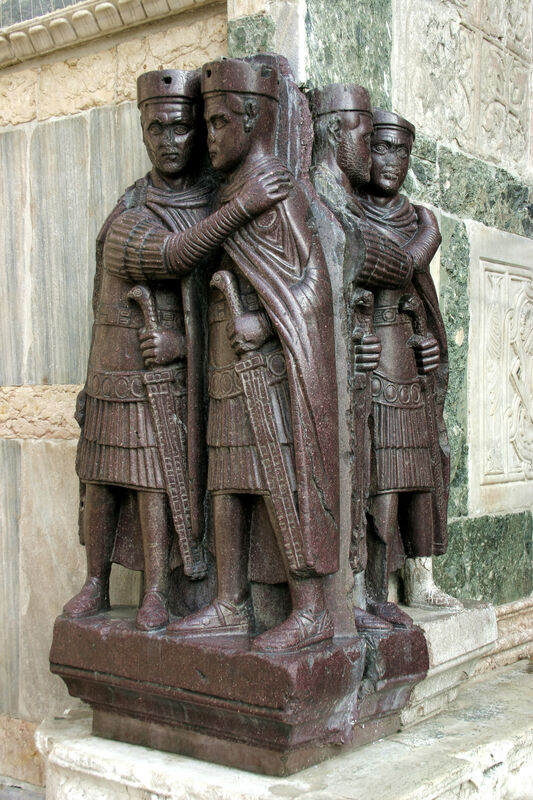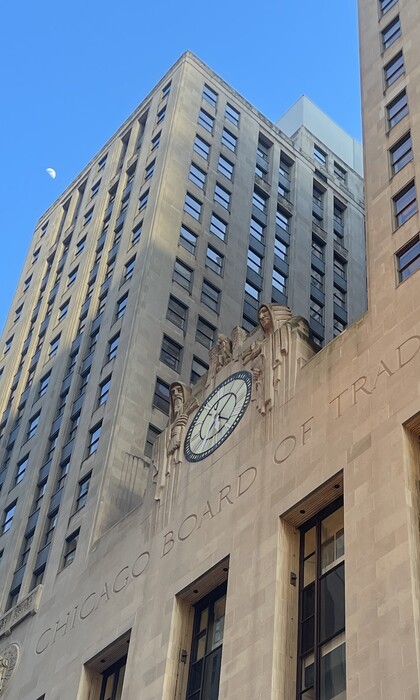László Földényi on the Four Tetrarchs
László Földényi:
In Venice, in an of the out-of-the-way corner of the Piazzetta located at the corner of the basilica of Saint Mark, there is a statuary group depicting the Four Tetrarchs. Carved out of the hardest granite, the sculpture, dating from the beginning of the fourth century, depicts Diocletian with three of his chosen co-sovereigns. They huddle together as if ready to brave the in- cipient end of the world.
– Dostoevsky Reads Hegel in Siberia and Bursts into Tears

Continuing:
Each draws our gaze; nonetheless, they are so uniform that no matter which one we begin to look at, we see the others as well. It does not matter with what small detail we commence our examination, we always perceive, involuntarily, the whole of the sculpture. Their shoes and their garments are uniform, their swords, crowns, and belts are uniform, the fabric on them is draped in a similar fashion, their foreheads are wrinkled in a similar manner, their gazes are uniformly careworn. There are four of them, and yet they appear to be one single living being.
Földényi identifies the sculptures with the “mass” in two ways. First, mass is what unites all things, a universal materiality that could be the divine. If matter as a whole is a divine unity, then being part of the whole elevates the individual, lightening the burden of individuation:
Human beings are themselves the crystallization of this cosmic “mass,” this fundament which can neither be enclosed nor bounded; our souls are nothing other than the “condensation” of the divine mass. We cannot step out of this mass-like existence, nor can we “state anything” about it, as every conjecture or declaration is made possible only by the mass. No matter what we might say about the mass, that statement would only be yet a further manifestation of the universal mass itself. And this universal mass does not recognize any difference between soul and body, between the dead and the living, between the material and the immaterial. Yet there is something divine within it—and human beings will have a connection to the divine for as long as we are able to vividly preserve within ourselves the experience of the cosmic roots of our own existence.
Second, mass is “a multitude of living people,” as in: the crowd, mass culture, a mass of humanity. Földényi argues that because of the two-sided valence to mass, the individual both craves and fears idenfication with the mass-es. Mass in the modern sense of “the crowd” is closer to the materiality of the body separated from the soul, thingness in opposition to life.
We shall feel the reassuring mass-like nature of our own exis-tence for as long as we maintain a healthy connection with the spirit. The bifurcation of the modern meaning of the word mass can be located in the disruption of this connection.
Then, materiality is something to fear. The life that has mass is, like all other matter, guaranteed to experience destruction:
Although I wasn’t struck by the Four Tetrarchs in the same way that it appears Földényi was, I walked around downtown seeing complements to his argument for the rest of the day. There is a vulnerability in the way two of the tetrarchs reaches across his body to grasp his partner. To me that outstretched arm, which makes the body of the potentate seem less bulky, skinner, weaker–that is the statue’s most distinctive feature.
For all the talk of mass, the tetrarch figures lack the indifferent, stone-like coldness that appear in Chicago’s more generic public sculptures:
